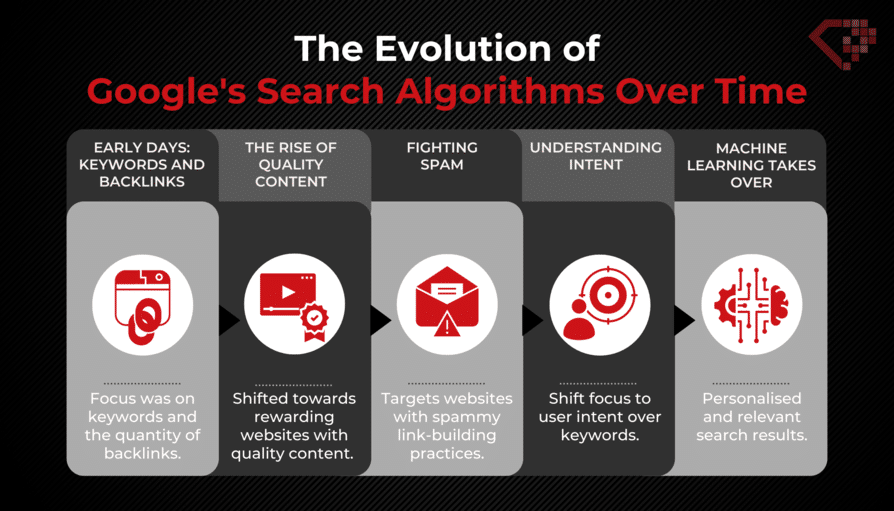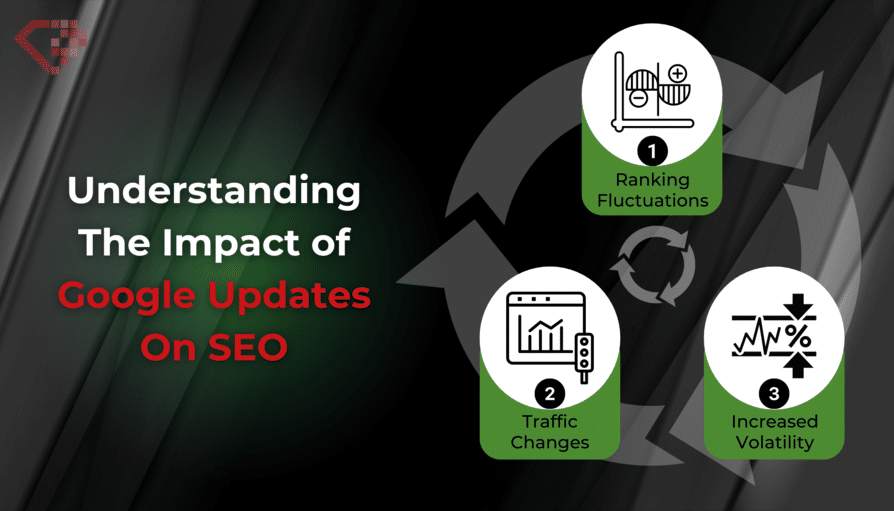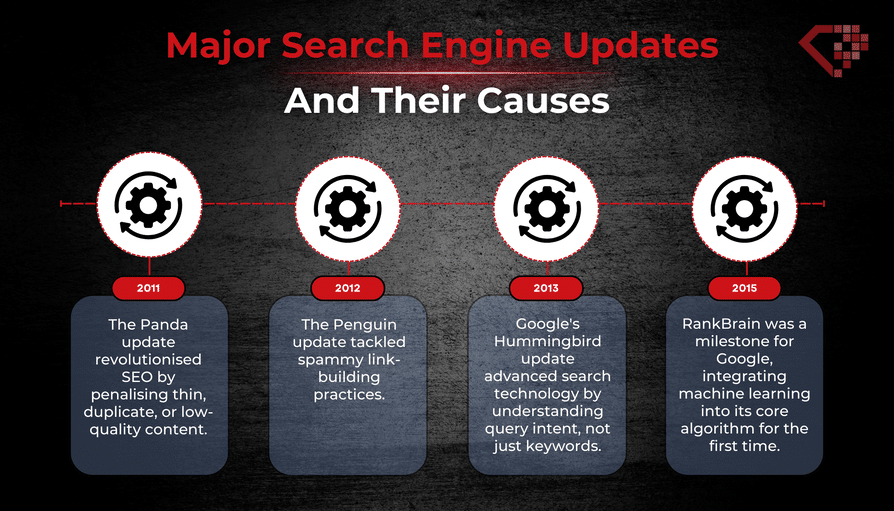Google is still very much the undisputed king of search engines, directing countless users to websites every day. What many website owners don’t realise though is that Google’s search algorithms (the complex systems that determine website rankings) are constantly shifting. These evolutions, known as Google search engine updates, can significantly impact your website’s visibility in search results.
Why should you care? Well, if you have spent countless hours building a beautiful website, you will not be thrilled to discover that it is buried on page ten of Google’s results. That is the potential reality for those who do not keep up with search engine updates.
In this blog post, our goal is to demystify the world of Google SEO algorithm updates. We will take you through a brief history of these updates, highlighting major events like Panda, Penguin, Hummingbird, and RankBrain. We will explain how these updates affect your website’s SEO, and why staying informed is crucial for maintaining and improving your online visibility.
The Evolution of Google’s Search Algorithms Over Time
Before we dive in, let us clarify what we mean by “search engine algorithm updates.” These are essentially changes that Google (or other search engines) make to their algorithms – complex systems that determine which websites rank highest in search results. These updates can be minor tweaks or major overhauls, and they can have a significant impact on your website’s visibility.
Google’s search algorithms have not always been the sophisticated systems they are today. In the early days of search engines, ranking factors were relatively simple, focusing on keywords and backlinks. But as the internet expanded and user behaviour evolved, so did Google’s approach.
Over the years, Google has rolled out various algorithm updates, each designed to improve the quality and relevance of search results for users. These updates have had a profound impact on SEO, forcing website owners to adapt their strategies to stay visible.
Here is a brief timeline of Google algorithm update history:
- Early Days: Keywords and Backlinks: In the early 2000s, Google’s algorithms primarily focused on keywords and the quantity of backlinks a website had. This led to practices like keyword stuffing (overloading a page with keywords) and buying links, which often resulted in low-quality websites ranking highly.
- The Rise of Quality Content: As Google recognised the need to prioritise quality, updates like Panda (2011) penalised websites with thin, duplicate, or low-quality content. This marked a shift towards rewarding websites that provided valuable, informative, and engaging content.
- Fighting Spam: Updates like Penguin (2012) targeted websites that engaged in spammy link-building practices. This emphasised the importance of earning backlinks naturally through high-quality content and genuine relationships.
- Understanding Intent: The Hummingbird update (2013) marked a major change in how Google interpreted search queries. It focused on understanding the intent behind searches, rather than just matching keywords. This meant websites needed to create content that answered the questions users were asking.
- Machine Learning Takes Over: RankBrain (2015) introduced machine learning to Google’s algorithms, enabling them to learn and adapt to user behaviour over time. This led to more personalised and relevant search results based on individual preferences and search history.
These are just a few examples of the more major updates Google has implemented over the years. Each update has brought about significant changes to search engine ranking factors, forcing website owners to stay on their toes and adapt their SEO strategies accordingly.
By understanding the history of these updates and the shifts in search engine priorities, you will be better equipped to ensure your website remains visible to your target audience.

Understanding The Impact of Google Updates On SEO?
What happens when a Google search engine update rolls out? The effects can vary significantly, but some common immediate impacts include:
- Ranking Fluctuations: Websites may experience sudden changes in their search rankings, either rising or falling depending on how well they align with the new algorithm.
- Traffic Changes: Fluctuations in rankings often translate to changes in organic traffic. Websites that gain rankings might see a surge in visitors, while those that lose rankings may experience a drop.
- Increased Volatility: The search results pages (SERPs) can become more volatile during update rollouts, with rankings shifting more frequently than usual.

How long does Google take to update SEO algorithms? The rollout time for updates can vary, ranging from a few days to several weeks. During this period, Google is essentially testing the new algorithm and gathering data to fine-tune it. This means the initial impact of an update might not be the final picture, as rankings can continue to fluctuate until the rollout is complete.
Major Search Engine Updates and Their Causes
#1 – 2011: The Google Panda Update
Rolled out in 2011, the Panda update was a game-changer in the world of SEO. Its primary goal was to improve the quality of search results by penalising websites with thin, duplicate, or low-quality content. In essence, Panda was Google’s way of saying, “Content is king, but only if it’s high-quality.”
Cause and Effect: Before Panda, some websites relied on keyword stuffing and other black-hat SEO tactics to rank higher. This often resulted in users being directed to pages with irrelevant or unhelpful content. Panda changed the game by rewarding websites that prioritised user experience and offered valuable, informative content.
Real-Life Impact: Imagine a travel website that once relied on copying and pasting content from other sources. After Panda, their rankings plummeted because their content was deemed low-quality. To recover, they had to invest in creating original, engaging articles that genuinely helped users plan their trips.
#2 – 2012: Google Penguin Update
The Penguin update, launched in 2012, targeted another major issue in the SEO landscape: spammy link-building practices. In the past, some websites manipulated search rankings by acquiring backlinks from low-quality or irrelevant sources. Penguin aimed to put an end to this by penalising websites with unnatural link profiles.
Cause and Effect: Penguin shifted the focus from quantity to quality when it came to backlinks. Websites could no longer rely on buying links or participating in link schemes to boost their rankings. Instead, they needed to focus on earning backlinks organically through valuable content and genuine relationships with other websites.
Real-Life Impact: Take an e-commerce store that once relied on buying backlinks from unrelated websites to improve their visibility. After Penguin, their rankings dropped significantly as Google recognised their unnatural link profile. To recover, they had to disavow those spammy links and focus on building relationships with relevant influencers and websites in their industry. Learn more about best-practice link building.
#3 – 2013: The Google Hummingbird Update
Google’s Hummingbird update represented a major leap forward in search technology. Instead of simply matching keywords, Hummingbird aimed to understand the meaning and intent behind a user’s search query. This meant that websites could no longer rely solely on keyword optimisation. Instead, they needed to create content that truly answered the questions users were asking.
Cause and Effect: Before Hummingbird, a search for “best running shoes” might have yielded results focused solely on those exact words, even if the user was looking for reviews or recommendations. Hummingbird changed that by considering the context and intent of the query, leading to more relevant and helpful results.
Real-Life Impact: Let us stay with that website that sells running shoes. Before Hummingbird, they might have focused their content on keyword-heavy product descriptions. After Hummingbird, they realised the importance of creating blog posts that answered questions like “how to choose the right running shoes” or “what are the best running shoes for beginners.” This shift allowed them to attract more targeted traffic and ultimately increase sales. Learn more about content marketing done right.
#4 – 2015: Google RankBrain and The Rise of Machine Learning
RankBrain marked another significant milestone for Google. It was the first time that machine learning, a type of artificial intelligence, was incorporated into Google’s core algorithm. This meant that RankBrain could learn and adapt over time, improving its ability to understand and interpret search queries.
Cause and Effect: Before RankBrain, Google’s algorithms relied on hand-coded rules to determine rankings. RankBrain changed that by introducing a self-learning element. This allowed Google to better understand complex or ambiguous queries and deliver more personalised search results based on individual user preferences and search history.
Real-Life Impact: Consider a user who frequently searches for “healthy recipes.” RankBrain would learn from their past searches and tailor future results accordingly, perhaps prioritising vegetarian options or recipes with specific ingredients. This personalisation leads to a better user experience and increases the likelihood of users finding the information they need.

In Closing
As we have seen, Google’s search engine updates can completely reshape the SEO landscape. From Panda’s emphasis on quality content, to Penguin’s crackdown on spammy links, Hummingbird’s focus on user intent, and RankBrain’s embrace of machine learning, each update has forced website owners to adapt.
The impact of these updates on your website’s SEO can be significant, affecting your rankings, traffic, and ultimately, your bottom line. In our next blog post, we will go deeper into practical strategies for handling the effects of Google’s updates. We will explore how to audit your website, identify potential issues, and adapt your SEO strategy.
And remember, if you’re feeling overwhelmed by SEO or other digital marketing strategies, or if you have any questions or concerns about how Google’s updates might affect your website, don’t hesitate to reach out to Ruby Digital. Our team of SEO experts and content marketing gurus is always here to help!



